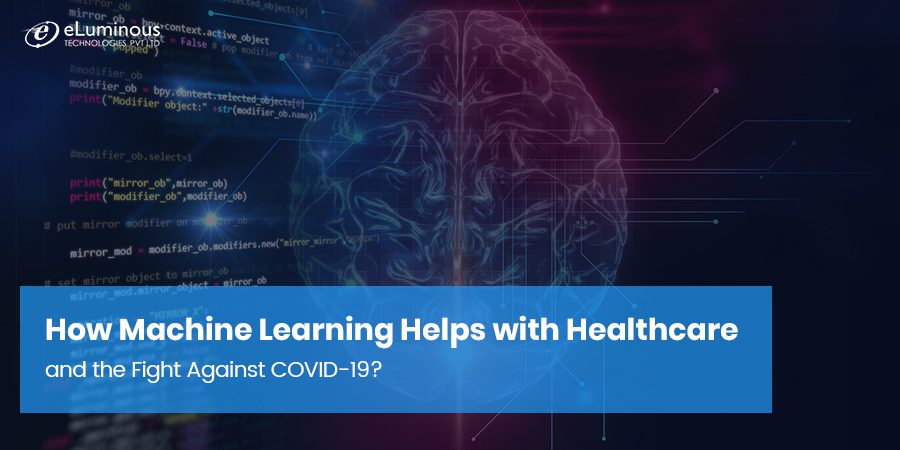The COVID-19 pandemic has brought to fore an inconvenient truth that most nations refused to acknowledge all this while – our healthcare systems are balanced on a precarious edge and all it takes is a black swan event like COVID-19 to tip them over.
In these uncertain times, machine learning has emerged as an unlikely force multiplier for the healthcare sector. As you’ll learn in this post, machine learning is helping the fight against COVID-19 in several ways, from identifying hotspots to accelerating drug research efforts.
But even before the pandemic, machine learning in healthcare was growing at a brisk pace. This Statista forecast puts the global healthcare AI (of which ML is a subset) market in 2025 at $28 billion. Needless to say, this figure will likely see an upward revision because of COVID-19.
In this post, we’ll look at the various ways in which machine learning can and is improving healthcare delivery. We’ll also look at examples of how machine learning is helping us fight the COVID-19 pandemic.
Machine Learning Implementations in Pharma and Medicine
Identifying Diseases and Diagnosis
Among the principal applications of machine learning in healthcare is the identification and diagnosis of hard-to-diagnose diseases such as genetic ailments and cancers that are harder to identify in their early stages. IBM’s Watson Genomics, which integrates cognitive computing with genome-based tumour sequencing for faster diagnosis, and P1vital, whose PReDicT is aimed at finding a cost-effective way of diagnosing and treating usual clinical conditions, are excellent examples of deploying machine learning for faster and more accurate disease diagnosis.
Medical Imaging Diagnosis
There’s widespread agreement among experts that medical images are the largest source of data in healthcare. Machine learning and deep learning can help healthcare providers parse actionable data from a huge number of medical images at a very rapid pace. Companies such as Enlitic and Sophia Genetics have done impressive work in this area by building ML-based tools to analyse medical imaging reports and diagnose abnormalities faster and with greater accuracy than human healthcare professionals.
Drug Development
Machine learning is also being used to bolster every step of the drug development process, from designing the chemical structure and target validation to testing drug safety and carrying out clinical trials. Quantitatively, ML is expected to accelerate the drug development process (currently pegged at a minimum of 10 years) and make it more cost-effective too. AtomNet, whose deep learning algorithm can sift through millions of potential molecules in a matter of days, and Microsoft’s Project Hanover, which uses ML for treating cancers and personalizing drug combinations for patients with AML (Acute Myeloid Leukaemia), offer working proof of ML’s usefulness in drug development.
Personalizing Medicine
ML is also helping to increase the efficacy of treatments by personalizing them as per an individual’s physiological makeup and medical history. For instance, researches are putting a patient’s genetic data, lifestyle data, electronic health records, sensor/wearables data, and environmental data through AI and ML technologies to develop personalized treatments for diseases ranging from depression to even cancer. IBM’s Watson Oncology is a fine example of this as it leverages data science to analyse a patient’s medical history and come up with multiple treatment options.
Clinical Research and Trials
Clinical trials are among the most vital and time-consuming stages of any drug development process. They also carry serious cost ramifications as stretched trial periods lead to drastically inflated overheads. Pharma companies can hasten this process while ensuring fidelity by adopting ML techniques like predictive analytics. This can help them create a pool of trial candidates using data points as varied as prior doctor visits or even social media. Once the trials begin, machine learning can help with real-time monitoring and data gathering of candidates and digitalizing records to eliminate source-based errors.
Smarter Health Records
For the majority of healthcare providers, maintaining up-to-date records of patients is a highly resource-intensive process. Machine learning can lighten this burden as it can speed up the process and save organizations plenty of money, effort, and time. Solutions such as Google’s Cloud Vision API, which offers ML-based document classification and OCR recognition technologies to discern handwriting, can help providers not only digitize but also create smarter patient health records to help with diagnostics and treatment suggestions.
Disease Outbreak Prediction
Machine learning is being extensively used around the world to monitor and predict the rise of epidemics. It helps scientists collate data from diverse sources such as websites, social media updates, and even satellites to predict the outbreak of diseases like malaria and other infections in different pockets of the world. This can prove handy for healthcare systems that suffer from inadequate medical infrastructure and poor public awareness. A proven example of this is ProMED, an email service launched in 1994 that was the first to report outbreaks related to SARS, MERS, and Ebola.
How Machine Learning is Helping the Fight Against COVID-19?
Several of the machine learning in healthcare implementations discussed above have made their presence felt in the global fight against COVID-19. Both government and private healthcare providers and pharma companies have taken to AI and ML for developing novel diagnostic approaches, large scale screening techniques of suspected patients, deep learning-based analyses of patients’ thoracic CT images for improved detection, and automated diagnostic systems to enhance diagnostic speed as well as accuracy. The latter is proving particularly useful in preventing the spread of the SARS-CoV-2 virus among healthcare workers by reducing their contact with COVID-19 patients.
For instance, BlueDot, an AI platform for tracking infectious diseases the world over, flagged an unusually high number of pneumonia cases in areas around a market in Wuhan, China. This was exactly nine days before the WHO (World Health Organization) officially confirmed the discovery of a novel strain of the coronavirus in a Wuhan resident hospitalized with pneumonia. BlueDot further accurately identified the cities where the new virus would spread to after originating in Wuhan.
Similarly, computer vision algorithms can be used to check if a person is suffering from COVID-19 symptoms like fever, breathing issues, and coughing. In China, the search giant Baidu is using a network of cameras equipped with computer vision and infrared sensors to forecast the temperatures of people in public areas. It’s capable of screening up to 200 people every minute and can measure their temperature within a margin of 0.5-degree Celsius. The system singles out anyone with a temperature of over 37.3 degree Celsius and has been installed at Qinghe Railway Station, Beijing.
Another important aspect in the battle against COVID-19 that is harnessing AI and ML is drug development. DeepMind, an AI research organization owned by Google, recently announced that it had started the use of deep learning to search for new information about the SARS-CoV-2’s protein structure. This is important in two ways, i) the process usually takes months and ii) understanding the virus’s protein structure will help with vaccine development.
Summing It Up
Before the COVID-19 pandemic, a lot of healthcare providers viewed machine learning as a technology for the future. But as this pandemic shows, there are several quantitative as well as qualitative benefits to be gained by investing in healthcare-centric machine learning platforms and tools. Regardless of which link you are in the larger healthcare chain, machine learning can provide you with immediate as well as long term tangible benefits.
As a healthcare data analytics company, we’ve helped several healthcare providers and pharma companies leverage the power of machine learning and related AI systems. Instead of a one-size-fits-all solution, we help identify specific areas in your processes that can benefit from machine learning implementations. Once identified, we help you build a bespoke data science system and integrate it with your technology stack.
To know more about our services and how we can help you make the most of machine learning in healthcare, get in touch with us now.
And if you liked this post, do subscribe to get crisp and highly informative blog posts delivered straight to your inbox every week. We cover a variety of topics on our blog including web and mobile development, data analytics, business intelligence, and eCommerce development, among others.
Thank you for reading. What did you make of these healthcare data analytics advantages? Did we miss out on any? Please share your thoughts in the comments section below.
Digital Marketing Manager
Responsible for developing and managing web presence, Sarah has been associated with eLuminous Technologies for 7+ years. Strategic and innovative with a passion for Content Marketing and enhancing brand awareness. Administered all business marketing operations and advertisement campaigns that eventually increased web traffic. She works under the motto “Think like a Publisher, not a Marketer.”


